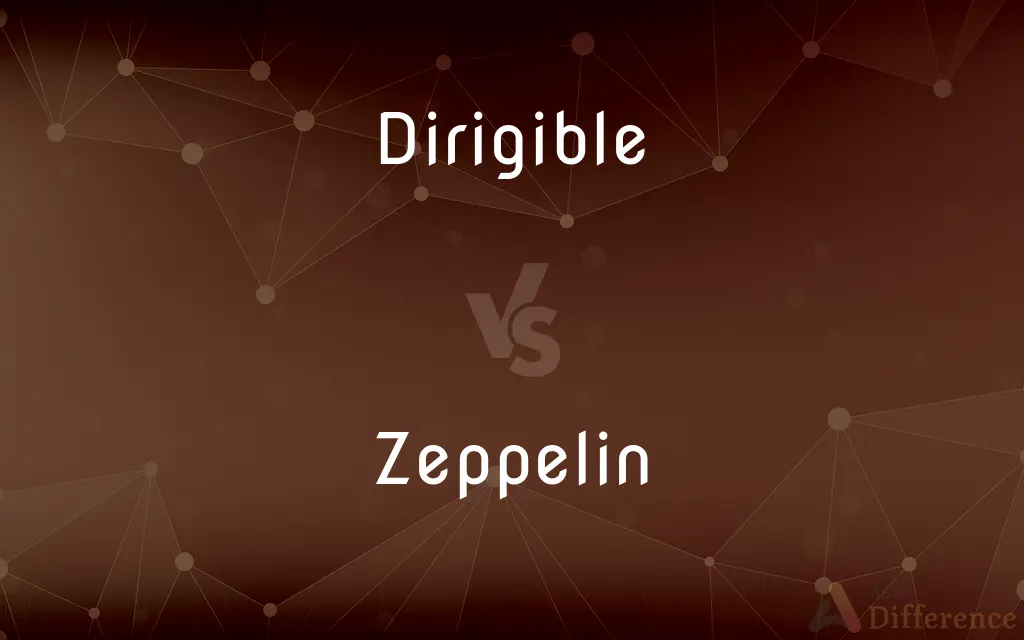Dirigible vs. Zeppelin — What's the Difference?
By Urooj Arif & Fiza Rafique — Updated on April 25, 2024
Dirigibles are any lighter-than-air craft that can be steered, while Zeppelins are a specific type of rigid dirigible.

Difference Between Dirigible and Zeppelin
Table of Contents
ADVERTISEMENT
Key Differences
Dirigibles encompass a broad category of airships including non-rigid, semi-rigid, and rigid types, designed for controlled flight. Whereas, Zeppelins specifically refer to large rigid airships originally developed by the German Count Ferdinand von Zeppelin in the early 20th century.
The structure of a dirigible can vary from having no internal framework (non-rigid) to having partial (semi-rigid) or full (rigid) metallic frameworks, which define their shape and durability. On the other hand, Zeppelins are characterized by their rigid framework made up of aluminum alloy rings and longitudinal girders, maintaining a fixed shape.
Dirigibles are generally used for various purposes including surveillance, research, and advertising due to their ability to hover and maneuver easily at slow speeds. In contrast, Zeppelins were historically used for passenger transport, reconnaissance, and military bombing during World War I and II due to their larger size and greater lift capacity.
The propulsion and navigation systems in dirigibles can vary significantly based on their design and intended use, ranging from simple propellers to more complex engines. Zeppelins, however, typically featured multiple engines mounted on external gondolas, which provided powerful thrust and better control for long-distance travel.
Today, dirigibles are seeing a resurgence in interest for eco-friendly transportation and aerial tourism, given their low fuel requirements and minimal environmental impact. Zeppelins, while not as commonly used, are still operational in certain areas, primarily for sightseeing and advertising, showcasing their historical significance and unique design.
ADVERTISEMENT
Comparison Chart
Definition
Any steerable lighter-than-air craft
A type of rigid dirigible developed by Count Zeppelin
Structure
Can be non-rigid, semi-rigid, or rigid
Always rigid with a framework of metal
Common Uses
Surveillance, research, advertising
Passenger transport, military applications
Propulsion and Control
Varies widely from simple to complex systems
Multiple engines on external gondolas
Historical Period
Used from the early 20th century to present
Most prominent in early to mid-20th century
Compare with Definitions
Dirigible
Capable of vertical takeoff and landing, making them suitable for varied applications.
Dirigibles are often used for aerial advertising due to their ability to hover over specific locations.
Zeppelin
A type of large rigid airship named after its inventor, Count Ferdinand von Zeppelin.
The Zeppelin, a marvel of early aviation, crossed the Atlantic in a record-setting flight.
Dirigible
Used for both military and civilian purposes, depending on its design.
During the war, the military employed dirigibles for long-range reconnaissance.
Zeppelin
A rigid airship having a long cylindrical body supported by internal gas cells.
A large rigid dirigible designed to carry passengers or bombs.
Dirigible
A lighter-than-air aircraft that is steerable and powered.
The dirigible floated above the city, providing a panoramic view to its passengers.
Zeppelin
Historically significant for its role in commercial air travel and military operations.
The Graf Zeppelin was famous for its around-the-world flight in 1929.
Dirigible
See airship.
Zeppelin
A Zeppelin is a type of rigid airship named after the German inventor Count Ferdinand von Zeppelin (German pronunciation: [ˈt͡sɛpəliːn]) who pioneered rigid airship development at the beginning of the 20th century. Zeppelin's notions were first formulated in 1874 and developed in detail in 1893.
Dirigible
(aviation) A self-propelled airship that can be steered.
Zeppelin
Alternative case form of Zeppelin
Dirigible
Steerable
Zeppelin
A dirigible balloon of the rigid type, consisting of a cylindrical trussed and covered frame supported by internal gas cells, and provided with means of propulsion and control. It was first successfully used by Ferdinand Count von Zeppelin.
Dirigible
Capable of being directed; steerable; as, a dirigible balloon.
Zeppelin
German inventor who designed and built the first rigid motorized dirigible (1838-1917)
Dirigible
A steerable self-propelled airship
Dirigible
Capable of being steered or directed
Common Curiosities
What are the safety concerns with Zeppelins?
The use of hydrogen, which is highly flammable, was a major safety concern for Zeppelins, as seen in the Hindenburg disaster.
What advancements have been made in dirigible technology?
Modern dirigibles often feature advanced materials for construction and more efficient engines for better maneuverability and environmental friendliness.
What materials are used to build a dirigible?
Dirigibles are typically made from lightweight materials like fabric envelopes filled with gases such as helium or hydrogen.
How do dirigibles stay afloat?
Dirigibles stay afloat by using gases lighter than air, such as helium, which provide lift.
What was the largest Zeppelin ever built?
The LZ 129 Hindenburg was one of the largest Zeppelins ever built, measuring over 800 feet in length.
What types of gases are used in modern dirigibles?
Modern dirigibles primarily use helium, due to its non-flammable properties, unlike the historically used hydrogen.
What are the limitations of using a dirigible for transportation?
Limitations include slower speeds, susceptibility to bad weather, and the need for large ground crews for takeoff and landing.
What are semi-rigid dirigibles?
Semi-rigid dirigibles have a partial rigid structure to maintain their shape but are not as structurally fixed as Zeppelins.
How do dirigibles maneuver?
Dirigibles maneuver using rudders and vectored thrust from their engines, allowing them to change direction and altitude.
How did Zeppelins impact air travel in the early 20th century?
Zeppelins were among the first to provide passenger air service across continents, significantly impacting early long-distance air travel.
How are dirigibles powered?
Dirigibles are powered by engines that typically drive propellers to steer and propel the airship forward.
Can dirigibles be used for tourism today?
Yes, dirigibles are used for aerial sightseeing tours, offering unique perspectives of landscapes and cityscapes.
What was a significant technological advancement in Zeppelin design?
A significant advancement was the introduction of the duralumin structure, which provided better durability and rigidity compared to earlier designs.
Were Zeppelins used in any wars?
Yes, Zeppelins were used extensively for reconnaissance and bombing missions during World War I.
What is the difference in capacity between dirigibles and Zeppelins?
Zeppelins typically had larger capacities for passengers and cargo due to their rigid structures.
Share Your Discovery

Previous Comparison
Association vs. Partnership
Next Comparison
Nook vs. RecessAuthor Spotlight
Written by
Urooj ArifUrooj is a skilled content writer at Ask Difference, known for her exceptional ability to simplify complex topics into engaging and informative content. With a passion for research and a flair for clear, concise writing, she consistently delivers articles that resonate with our diverse audience.
Co-written by
Fiza RafiqueFiza Rafique is a skilled content writer at AskDifference.com, where she meticulously refines and enhances written pieces. Drawing from her vast editorial expertise, Fiza ensures clarity, accuracy, and precision in every article. Passionate about language, she continually seeks to elevate the quality of content for readers worldwide.
















































